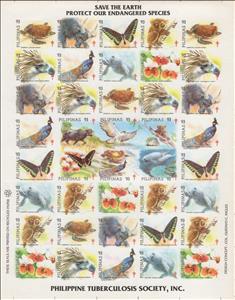Mini Sheet: Save the Earth: Protect our Endangered Species (Cinderellas 1993)
Save the Earth: Protect our Endangered Species (Cinderellas 1993)
01 January (Cinderellas ) within release Philippines goes into circulation Mini Sheet Save the Earth: Protect our Endangered Species face value None No Face Value
| Mini Sheet Save the Earth: Protect our Endangered Species in catalogues | |
|---|---|
| Colnect codes: | Col: PH 1993-MS |
Mini Sheet is square format.
Also in the issue Philippines:
- Stamp - Bird-Wing Butterfly face value None;
- Stamp - Bird-Wing Butterfly and Waling-Waling face value None;
- Stamp - Dugong face value None;
- Stamp - Dugong face value None;
- Stamp - Pawikan face value None;
- Stamp - Pawikan and Tandikan face value None;
- Stamp - Philippine Eagle face value None;
- Stamp - Philippine Eagle face value None;
- Stamp - Tamaraw face value None;
- Stamp - Tamaraw face value None;
- Stamp - Tandikan face value None;
- Stamp - Tarsier face value None;
- Stamp - Tarsier face value None;
- Stamp - Waling-Waling face value None;
- Mini Sheet - Save the Earth: Protect our Endangered Species face value None;
Mini Sheet Save the Earth: Protect our Endangered Species it reflects the thematic directions:
Animals are multicellular, eukaryotic organisms of the kingdom Animalia (also called Metazoa). All animals are motile, meaning they can move spontaneously and independently, at some point in their lives. Their body plan eventually becomes fixed as they develop, although some undergo a process of metamorphosis later on in their lives. All animals are heterotrophs: they must ingest other organisms or their products for sustenance.
Environmental protection is the practice of protecting the natural environment by individuals, groups and governments.Its objectives are to conserve natural resources and the existing natural environment and, where it is possible, to repair damage and reverse trends.
A flower, sometimes known as a bloom or blossom, is the reproductive structure found in plants that are floral (plants of the division Magnoliophyta, also called angiosperms). The biological function of a flower is to effect reproduction, usually by providing a mechanism for the union of sperm with eggs. Flowers may facilitate outcrossing (fusion of sperm and eggs from different individuals in a population) or allow selfing (fusion of sperm and egg from the same flower). Some flowers produce diaspores without fertilization (parthenocarpy). Flowers contain sporangia and are the site where gametophytes develop. Many flowers have evolved to be attractive to animals, so as to cause them to be vectors for the transfer of pollen. After fertilization, the ovary of the flower develops into fruit containing seeds. In addition to facilitating the reproduction of flowering plants, flowers have long been admired and used by humans to beautify their environment, and also as objects of romance, ritual, religion, medicine and as a source of food.



